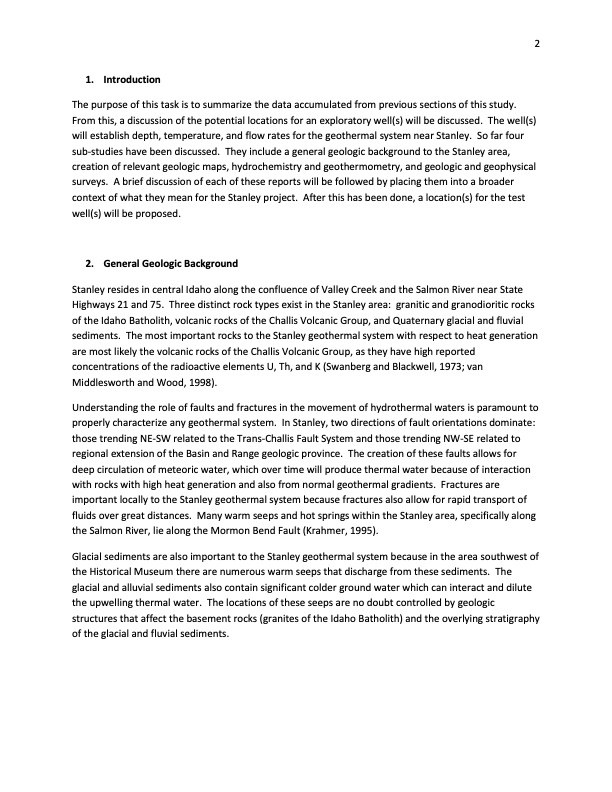
PDF Publication Title:
Text from PDF Page: 002
1. Introduction The purpose of this task is to summarize the data accumulated from previous sections of this study. From this, a discussion of the potential locations for an exploratory well(s) will be discussed. The well(s) will establish depth, temperature, and flow rates for the geothermal system near Stanley. So far four sub-studies have been discussed. They include a general geologic background to the Stanley area, creation of relevant geologic maps, hydrochemistry and geothermometry, and geologic and geophysical surveys. A brief discussion of each of these reports will be followed by placing them into a broader context of what they mean for the Stanley project. After this has been done, a location(s) for the test well(s) will be proposed. 2. General Geologic Background Stanley resides in central Idaho along the confluence of Valley Creek and the Salmon River near State Highways 21 and 75. Three distinct rock types exist in the Stanley area: granitic and granodioritic rocks of the Idaho Batholith, volcanic rocks of the Challis Volcanic Group, and Quaternary glacial and fluvial sediments. The most important rocks to the Stanley geothermal system with respect to heat generation are most likely the volcanic rocks of the Challis Volcanic Group, as they have high reported concentrations of the radioactive elements U, Th, and K (Swanberg and Blackwell, 1973; van Middlesworth and Wood, 1998). Understanding the role of faults and fractures in the movement of hydrothermal waters is paramount to properly characterize any geothermal system. In Stanley, two directions of fault orientations dominate: those trending NE-SW related to the Trans-Challis Fault System and those trending NW-SE related to regional extension of the Basin and Range geologic province. The creation of these faults allows for deep circulation of meteoric water, which over time will produce thermal water because of interaction with rocks with high heat generation and also from normal geothermal gradients. Fractures are important locally to the Stanley geothermal system because fractures also allow for rapid transport of fluids over great distances. Many warm seeps and hot springs within the Stanley area, specifically along the Salmon River, lie along the Mormon Bend Fault (Krahmer, 1995). Glacial sediments are also important to the Stanley geothermal system because in the area southwest of the Historical Museum there are numerous warm seeps that discharge from these sediments. The glacial and alluvial sediments also contain significant colder ground water which can interact and dilute the upwelling thermal water. The locations of these seeps are no doubt controlled by geologic structures that affect the basement rocks (granites of the Idaho Batholith) and the overlying stratigraphy of the glacial and fluvial sediments. 2PDF Image | Stanley Geothermal Feasibility Study

PDF Search Title:
Stanley Geothermal Feasibility StudyOriginal File Name Searched:
Stanley_Geothermal_Feasibility_Study_Task_5_Report.pdfDIY PDF Search: Google It | Yahoo | Bing
NFT (Non Fungible Token): Buy our tech, design, development or system NFT and become part of our tech NFT network... More Info
IT XR Project Redstone NFT Available for Sale: NFT for high tech turbine design with one part 3D printed counter-rotating energy turbine. Be part of the future with this NFT. Can be bought and sold but only one design NFT exists. Royalties go to the developer (Infinity) to keep enhancing design and applications... More Info
Infinity Turbine IT XR Project Redstone Design: NFT for sale... NFT for high tech turbine design with one part 3D printed counter-rotating energy turbine. Includes all rights to this turbine design, including license for Fluid Handling Block I and II for the turbine assembly and housing. The NFT includes the blueprints (cad/cam), revenue streams, and all future development of the IT XR Project Redstone... More Info
Infinity Turbine ROT Radial Outflow Turbine 24 Design and Worldwide Rights: NFT for sale... NFT for the ROT 24 energy turbine. Be part of the future with this NFT. This design can be bought and sold but only one design NFT exists. You may manufacture the unit, or get the revenues from its sale from Infinity Turbine. Royalties go to the developer (Infinity) to keep enhancing design and applications... More Info
Infinity Supercritical CO2 10 Liter Extractor Design and Worldwide Rights: The Infinity Supercritical 10L CO2 extractor is for botanical oil extraction, which is rich in terpenes and can produce shelf ready full spectrum oil. With over 5 years of development, this industry leader mature extractor machine has been sold since 2015 and is part of many profitable businesses. The process can also be used for electrowinning, e-waste recycling, and lithium battery recycling, gold mining electronic wastes, precious metals. CO2 can also be used in a reverse fuel cell with nafion to make a gas-to-liquids fuel, such as methanol, ethanol and butanol or ethylene. Supercritical CO2 has also been used for treating nafion to make it more effective catalyst. This NFT is for the purchase of worldwide rights which includes the design. More Info
NFT (Non Fungible Token): Buy our tech, design, development or system NFT and become part of our tech NFT network... More Info
Infinity Turbine Products: Special for this month, any plans are $10,000 for complete Cad/Cam blueprints. License is for one build. Try before you buy a production license. May pay by Bitcoin or other Crypto. Products Page... More Info
| CONTACT TEL: 608-238-6001 Email: greg@infinityturbine.com | RSS | AMP |